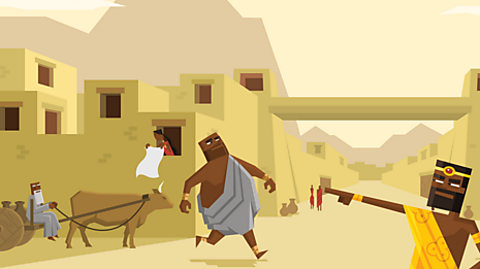What was the Indus Valley?
The Indus Valley was home to one of the world's first large civilisations. It began nearly 5,000 years ago in an area of modern-day Pakistan and Northern India.
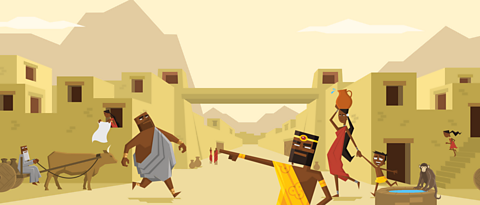
There were more than 1,400 towns and cities in the Indus Valley.
The biggest were Harappa and Mohenjo-Daro. Around 80,000 people lived in these cities.
The names Harappa and Mohenjo-Daro were given to the cities in later times.
We do not know what the Indus people called their cities, because nobody has been able to translate their ancient language.
Watch: Life in the Indus Valley
Narrator: Hello, future people of the UK. I’d like to show you what it’s like to live in the ancient Indus Valley, one of the earliest civilisations, so we’re a long way back in time.
Back before the Vikings… before the Romans and keep going back, back, back until Stonehenge is being built 4,500 years ago.Head south-east over Europe and you’ll see us, just before India.
You can’t miss us – we’re about four times the size of Britain! Aha, you made it! Hi, I’m Suri.
I can’t wait to show you around our village. We’re farmers, by the way, and like all Indus people, we survive from what we can sell.So today Mum has made a special trip to sell our grain in the big city.
Hang on! But she won’t sell anything without these! These are Mum’s seals – I’ll explain later, but they’re really important.So I need to get them to her pronto.
Never mind the village – you’re getting the city tour instead.
Don’t be intimidated by the walls – they’re not to keep invaders out, they’re to keep water out.
We’re called Indus Valley people because we live – surprise, surprise – in the valley river.
It brings all sorts of benefits, like farming, irrigation and travel, but it can be a bit of a bad neighbour and occasionally tries to wash us away. And wait til you see inside.
Some cities are higgledy-piggledy – not ours.
We built some of the first planned cities ever, so the sewers, the roads and the buildings all fit together in a grid system. And down the middle is a big, wide, straight street, just wide enough, in fact, for two elephants to pass side-by-side.
ELEPHANTS TRUMPET
You’d call it a ‘high street’ – we were using the same idea 4,500 years before you.
HORNS BEEP
She’s got to be around here somewhere. Hang on – that looks like my uncle. He’s a builder, can’t you tell?
We don’t have stones around here so, just like you, we use bricks, all baked from clay.
They’re very durable, lasting for thousands of years, which is how your historians will find out about us.
So as you know, our houses have all the mod cons, including personal wells and flushing toilets.
We’re actually one of the first people in the world to have those.
Uncle, any idea where I can find Mum?
Second right, first left – got it.
Check this out! We’re really big gamers in the Indus Valley, and this one is so addictive that I bet you’ll still be playing it in your time.At last the market – I love it here. They’ve got clothes, toys. And just look at this necklace.
In fact, all our products are so great that people come from miles away just to buy them, but money hasn’t been invented yet - we just trade things instead.
It’s just like swapping things, but once the swap is made, it’s made for good. But people don’t like to buy anything without one of these seals.
Don’t worry if you can’t read it. No-one from your time has figured out what it says yet. They tell the buyer who made the goods, so they’re a bit like logos.
Would you ever buy a pair of trainers without the right logo?
Without our seals, Mum wouldn’t be able to sell our grain. So, yikes! Now, which way was I supposed to be going again?
Phew! I’m back on main street. Thank heavens for the grid system. Let’s try again – second right, first left.
Yes! There she is.
I think you’ll be needing these. Ah, shucks, don’t mention it! Wow, thanks, Mum. Pocket money!
COCK CROWS
Well, that’s about it. Our way of life is still a bit of mystery in your time. But, needless to say, it didn’t last forever.
The river here dried up and we were forced to move away. And all this? Well, it’ll be history.
Where was the Indus Valley?
The Indus people lived on the banks of the Indus river, the longest river in Pakistan.
The Indus river begins high up in the Himalayan mountains (the tallest mountain range in the world), and flows nearly 3,000 kilometres to the Arabian Sea. As the river moves downstream it carves out a valley. This is where the Indus people settled.
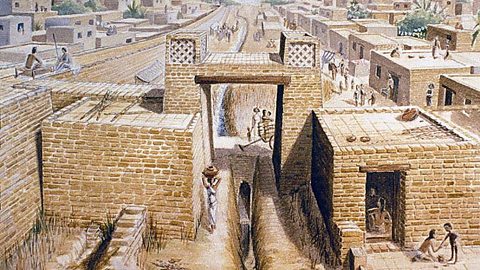
The first farmers liked living near the river because it kept the land green and fertile for growing crops. These farmers lived together in villages which grew over time into large ancient cities, like Harappa and Mohenjo-Daro.
The Indus people needed river water to drink, wash and to irrigate their fields. They may also have used water in religious ceremonies. To the Indus people, their river was ‘The King River’.
Was the Indus Valley a peaceful place?

The Indus civilisation seems to have been a peaceful one. The cities were built with strong walls and gateways, which usually means they needed protection. However few weapons have been found and there is no evidence of an army.
Ancient writings can tell us about civilisations, but no one has been able to translate the Indus writings. We have to look for other clues.
Sometimes you are able to see changes in ruins that indicate wars or battles, but the Indus Valley seems to have stayed the same for hundreds of years.
However, archaeologists have recently found some skeletons that suggest that the Indus valley might not have been such a peaceful place after all. When they looked closely at the skeletons, they saw that they might have died in a pretty nasty way - being beaten with a heavy club.

Town planning
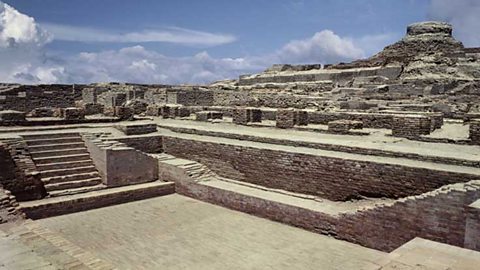
The Indus cities were neatly planned. They had straight roads which criss-crossed in a grid pattern to form city blocks.
The main streets were almost 10 metres wide - wide enough for two bullock carts or elephants to pass each other.

Drains ran along the edge of the streets to carry rubbish away and wells were dug for clean water.
Some cities, like Mohenjo-Daro, had high walls. These walls had gateways so people could come and go. Some city districts inside were raised on mounds. The highest mound was known as the citadel, which might have been where the priests or rulers lived.
Most Indus buildings were made from mud bricks. Over time, people built new houses on top of old ones. So, over hundreds of years, the cities grew higher and higher. Some houses were seven metres above the old houses at the bottom!

What was happening in Britain?

Activities
Activity 1: Indus cities
Click on the labels below to find out more about the cities in the Indus Valley.
Activity 2: Quiz – Who were the Indus people?
SAT’s preparation resources. activitySAT’s preparation resources
Get ready for the SATs papers with videos, activities, quizzes and games to refresh your knowledge and practise your skills.

More on Indus Valley
Find out more by working through a topic
- count4 of 8
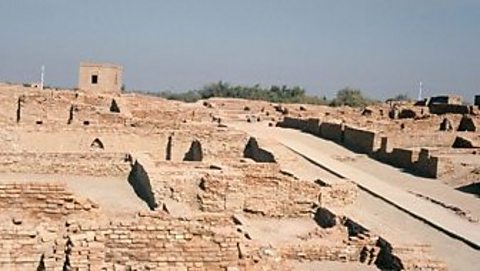
- count5 of 8
